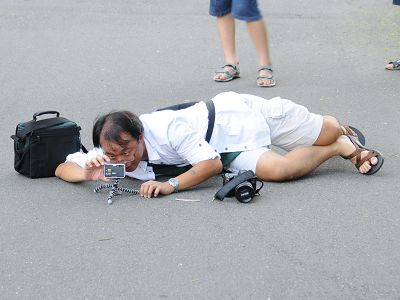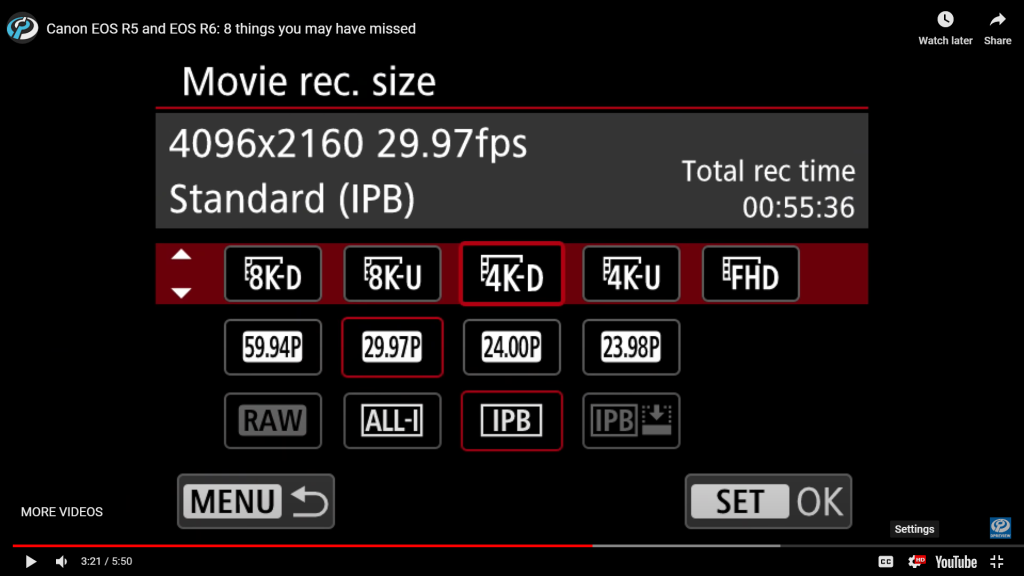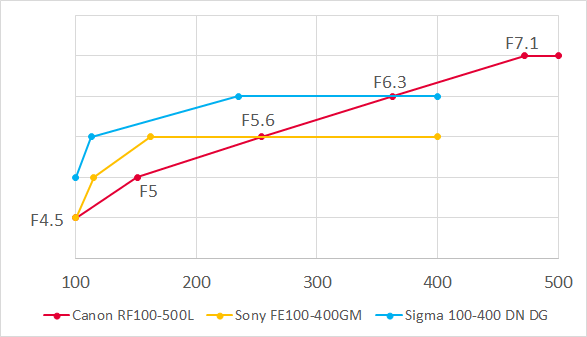OK I’ll admit it. I have underestimated Canon this time. To my defense it’s because in the past years I’ve constantly overestimated them.
In my failed prediction I said:
“my guess is that R5 is gonna be good enough that Canon users are happy to pay for it with some extra push of brand loyalty, but also crippled enough to give hardcore Sony fanboys some relieves.”
The more I look at EOS R5/R6’s spec sheet and early reviews (propaganda?), the more I realize that this is probably not the case. Canon’s not pulling their punches this time. Even if they cripple the camera a little bit here or there (for example it seems like R6’s crop 4K is interpolated just like EOS M6II, and there is no All-I compression), R5/R6 are most probably still the best cameras in their class, and they are the closest things to perfection. They pack almost everything you could ask for, and even the price is fair enough. I don’t feel any relief. I feel like a Canon fanboy now.
I do think 20MP is too limited based on my experience with RX10/100, but R6 probably does one thing better than R5 thanks to the lower resolution: its 4K60P video might be oversampled just like 1DXIII. If that’s true then R6 is basically the A7SIII that you’ve been waiting for: 2-axis screen, good IBIS, DPAF, Oversampled 4K60P, 10B422 internal recording. And it only cost $2500. This camera has just rendered the entire Panasonic full frame line obsolete (it even looks like Canon has some grudges with the M43 duo). Sony’s happy hour is also over, if they don’t get serious enough quickly, I’m not sure whether JIP wants to buy another camera department.
The Pursuit Of Ultimate Performance Is Coming To An End
Can Sony catch up? Well, performance wise I don’t think it’s so difficult for them to make a 45MP/20FPS/8K RAW/4K120P camera. They can probably do better. The real issue is that after EOS R5/R6 these specs are not that important anymore, because they are good enough for most people. For some maybe too good to handle. It’s just like I don’t have the urge to upgrade to an A7RIV because my computer is already slightly struggling with 42MP files. A 256G CFX card can only record 13min of 8K RAW video or 18min of 4K120P. If you can handle the 8K RAW workflow, then EOS R5 is probably just a very cheap toy for you.
I’m not saying that EOS R5 is the ultimate beast that doesn’t need any upgrades anymore. There are few things I can bitch about like 4K60P/120P is most likely not oversampled or the 20FPS burst mode probably has a lot of rolling shutter and much reduced dynamic range. But we are getting closer and closer, and this has changed my view about what’s a good camera. Performance is just the new baseline now. To further prove your worth, you need something better than 16K RAW or 4K240P or 50FPS burst or whatever. And this is exactly where Canon beats the crap out of Sony.
Canon’s Deadly Blows
IBIS
It is said that the Earth rotation limits the performance of IBIS to 6.3 stops but apparently some manufacturers no longer care about Earth’s feelings anymore. Just kidding, I guess Earth’s rotation has a different frequency signature than human motions so maybe it can be differentiated.
I did say that Canon is probably the king of mechanics in the industry but it’s still quite shocking to see them crushing their competitors in the first attempt. Of course I don’t buy Canon’s propaganda completely or the CIPA rating shit (after all Sony is also rated 5.5 stops) but some initial footage show that at least they do look good in the video mode. Sony’s IBIS on the other hand, is crap. In the past years it’s no big deal because Fuji still can’t fix their video AF and Panasonic is beyond fixable. Well now you have a new sheriff in town. If Sony doesn’t fix their shit in the next announcement then it’s gonna look very very ugly. I’ll never abandon my tripod unless the camera can float in the air by itself, but between two powerhouses that can both suit my needs, of course I’m choosing the one that can shoot 1-second exposure and nice handheld video. I hate gimbals to be honest.
The IBIS issue is becoming Sony’s Achilles Heel. After so many years I do wonder if Sony can really fix it. Maybe their engineers are just incapable. Or maybe E-mount is indeed too small for IBIS? That’s scary for sure.
Dual-Pixel AF
I told you guys that dual-pixel AF + slow sensors is not going to change the game but now Canon has faster sensors, so dual-pixel AF is going to show its true colors. It has the highest resolution we’ve ever seen (F22 AF in the center area! What the fuck!!), better low-light capability (-6EV with F1.2 lens) and the Dual Pixel RAW can build a full depth map that enables computational photography.
EOS R5 has a new function called Portrait Relighting which is similar to what iPhone has years ago. It’s not the most useful gimmick on iPhone but here is the deal: you can only measure the distance accurately by having a larger circle of confusion, or bokeh. iPhone has no bokeh. Their entire system is probably based on face recognition instead of a depth map and that certainly limits its capability. EOS R5 is a completely different story. You put a 50mmF1.8 there and it’s better than any TOF sensor in a flagship smartphone.
Canon didn’t say a lot about this new function, so maybe it’s still not that good (you do need some very sophisticated desktop software to fully exploit it). But it will be there in the future. And there are a lot more functions that can be implemented with the dual-pixel RAW. If Sony doesn’t use dual-pixel AF or something better like the quad-pixel AF, they’ll never be able to pull the same trick. Currently they are already losing on the minimum usable aperture and the low light capability.
2-Axis Screen
Of course it’s no difficulty for Sony to implement such a screen. They’ve already foreshadowed it on the ZV1. But you never know, maybe they are still living in their own dreams. When I shoot low angle vertically with a Sony camera I do feel like a moron.

User Interface
It’s not something I consider that important in the past but when performance is no longer the differentiate factor, it is the trivial things like this that set the camera apart. Needless to say Canon is doing a much better job than Sony overall, despite of some stupid designs like removing the mode dial or putting the power button on the left (I’m a daddy now so I hate it even more). And they are still polishing it. Here is the interface of 1DXIII:

And this is EOS R5:

Just look at it. Let that sink in.
Now I’ll repeat myself again. I have no doubt that Sony can make an equally powerful or even more powerful camera. I’m worrying about the overall user experience. There are other features I desire, like Olympus’s ND filter emulation, Sony’s good old smooth reflection, focus stacking needless to say, internal RAW processing and a lot more. In the era of excessive performance, these are the things that matter. And Sony has been doing a really really bad job in the past years.
3rd Party RF Lenses Are On The Horizon Now
I think Sony is actually doing quite well on their latest lenses. RF on the other hand is still in its infant phase, with some weird entries like the F11 primes. Personally I don’t find their out-of-the-box thinking as intriguing as Tamron, with maybe one exception:

Anyway the RF vs E lenses debate won’t matter that much in the near future. Sigma and Tamron are going to join the crusade very soon especially after the announcement of R5/R6. It’s just foolish to not to do so. After all RF protocol = EF protocol + some extra features (however the cooperation between the body and the lens for stabilization could be a challenge. The worst case scenario is that no 3rd party lenses get any IBIS at all. That’s gonna hurt badly for Canon users).
The three companies combined can make probably more than 15 lenses annually, plus RF mount will get all the available 3rd party options for E-mount in an instant. In two years it’s going to be a super strong system. I only use Sigma/Tamron lenses at the moment so when they joined the RF camp, lenses will be no longer a concern for me.
Will Z-mount also get some 3rd party love? Maybe yes maybe no. L-mount? Tamron doesn’t have time for the loser.
Sony’s Upper Hands
Well they are not entirely hopeless.
Tracking Algorithm
They now have the best tracking algorithm in the industry and maybe also the best deep learning capability. Meanwhile Canon is still lagging behind Nikon according to DPReview’s 1DXIII review. But I’m not sure if that matters that much. The rule of diminishing marginal utilities certainly applies here.
Sensor Technologies
Currently it looks like Canon’s power consumption is still much higher than Sony based on their CIPA rating. The huge discrepancies between the EVF and the LCD mode indicates that it’s most likely the sensor’s fault. The worst scenario is that R5/R6 being constantly haunted by the overheating issue for video shooting. That’s gonna be a deal breaker for those who make videos for a living. Actually it already looks like Canon is gonna flop big here according to some early reports. They are probably pushing their lagged-behind technology too far.
Besides that there are plenty of deadly weapons in Sony’s arsenal. But I don’t really feel like talking about a 42MP A9 or some other empty promises anymore. Previously we were just doing some mind masturbation about future possibilities. Now it has come to the point that Sony can’t fool around with their normal BSI shit anymore. They either bring out some big guns out of their basement or they can hide themselves there and never come out.
There is one technology I’d like to talk about though: the Quad-Bayer filter.
Quad-Bayer
This is not some cutting edge technology that Canon can’t copy, but Sony surely has some more experience about it. It seems to me that QB is the only solution to combine high resolution and high speed for a traditional sensor. EOS R5 won’t be able to do oversampled 4K60P unless it’s more than twice faster than the 1DXIII, which I don’t think is the case. But for a QB sensor it’s just a piece of cake. Plus it brings you quad pixels autofocus (= cross-type focus point) and real-time HDR exposure. Just imagine a 20MP A7SIII that can output 80MP files, that’s gonna be something. My spider sense keeps telling me that a Quad-Bayer full frame camera might be on its way now.
Size Does Matter (At Least For Me)
Now this is where Sony really does well:

EOS R5 is even thicker than the S1R, calculating from the mount to the back of the EVF. This distance determines the overall length of the body + lens combination. There is no way I’m going to buy those two bricks from Canon, otherwise there won’t be too many lenses left for me to choose from given the limited width of my Cosyspeed bag. I’m not kidding about “choosing the gears for the bag”. If you can’t even carry/access your gears with ease then you’ll just use it less often. And Cosyspeed has brought me unmatched user experience that I can’t use any other bag anymore.
The main problem with Canon’s R line is that the EVF hump is significantly larger than Sony/Nikon, and it fucking sticks out. Panasonic also has a huge head but at least that EVF has a crazy 0.83x magnification. I’m not sure what’s Canon’s excuses. Nikon move the hump a little bit back probably just trying to win a beauty pageant. It could have been slimmer. It seems to me that Sony is the only company that still try to make compact full frame cameras (Sigma’s toy doesn’t count), and I certainly appreciate that.
I do understand that not that many people share my enthusiasm of compact full frame cameras. Actually many people consider the A7 line too small for their hands.
Besides their huge ass EVF, most people don’t realize that CFX card actually has a big impact on the camera body size. Even the monstrous S1R can’t stack two CFX card slot vertically. I do think Sony is being smart not to jump on the CFX Type B ship. Canon/Panasonic’s SD+CFX hybrid setup doesn’t make a lot of sense. Eventually they’ll have to switch to CFX+CFX, and that’s gonna be very painful for their designer.
Type A or the proprietary SFX is not commercially available at the moment but if someone decides to use them then they will be there. Sony can even make their own cards.
Canon’s Forward Thinking
Canon is using the new HEIF format with the HDR support. HDR for photos is quite different from HLG for videos. HLG is already widely supported by high-end televisions now, while HDR photos… well let’s say it’s a fucking mess in almost every aspect, video cards, windows, PC monitors, you name it.
(Funny that PC monitors are basically garbage now compared to TVs. The only problem of TVs is that they are actually too big to be monitors. But I am thinking about getting a 48 inch LG CX, which is the smallest high-end TV you can find, as a computer monitor. Hopefully it won’t break my neck).
If you can figure the HDR workflow out then you’ll find that HDR is going to boost your image quality to a whole new level (but only on your own screen). Bright isn’t just white but truly bright. In the TV industry it’s probably the most revolutionary thing in the last decade. Unfortunately nobody in the photo industry is trying to push it to the customers except maybe Apple. There is still a very long way to go but I definitely appreciate Canon standing out and being a leader here.
Final Words
There is no doubt that Canon has just dropped two huge bombs in the camera world, and they are going to shape the landscapes for sure.
Panasonic is totally destroyed. You have to be insane to invest in their stupid cameras. So fucking huge and so fucking incapable. They better sell their camera department before its value plummets. Or make a wish while the comet is still there, that R5/R6 just burn themselves while shooting 4K videos.
Canon’s going to steal a lot of market share from Sony if Sony doesn’t act strong and quickly. They needs to mend their ways completely. Bring out some secret sensors, drastically improve their IBIS and user experience, stop using their stupid one-axis screen. Unfortunately I don’t have too much faith on their user experience or the IBIS, so their secret sensors better be insanely good, like we-can-get-rid-of-the-mechanical-shutter good. I’m still a big fan of compact cameras so I do hope that they unleash their full power this time. Otherwise E-mount is going to be the new A-mount.
Nikon’s fate depends on a lot of factors so it’s premature to draw any conclusion. Well uncertainty is already bad enough. Doesn’t look like a very bright future in my opinion.
Fuji is like a cockroach that can survive any nuclear apocalypse in their APS-C/44*33/Instax crevices. Don’t worry about them.
Pentax is always the best.

One thought on “EOS R5/R6: More Than A Wake Up Call?”